Fixing Air Leaks and Improving Home Insulation
by Mark Row
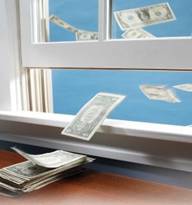 What can You Do for your Home Thermal Performance
What can You Do for your Home Thermal Performance
People are becoming increasingly aware of the importance of having an air sealed home not only because this can help creating a healthy atmosphere within your home but also because it can lead to significant savings, both during the summer and winter. Air leakage can not only create a tunnel which will lead the warm air out but also create a passage for all the moisture and water vapour which can easily collect behind your walls and cause a much more serious damage. This is why fixing air leaks and improving home insulation is extremely important.
Now, the first step in dealing with the named problem is determining potential leaks both inside and outside your home, and finally choosing the right method and material to fix the problem. It is good to know that there are a few spaces and areas within your home that are the most common sources of air leaks. However, this does not mean that other spaces should not be checked as well, since fixing one problem and ignoring the other one will leave you with an unsatisfying overall result. But, let’s take it one step at the time.
The First Step – Detecting Air Leaks
This step includes conducting a detailed inspection of your home, both inside and out. Know that you do not have to be a genius or a trained professional, but there are a few easy tests you can perform in order of determining which spaces need to be sealed and insulated. We will herewith try to point out some most problematic areas all in order of easing your task and saving you same time.
First things first, there are a few simple tests you can try performing in order of determining whether you dealing with air leaks. One is called the building pressurization test which includes shutting all doors and windows, turning off all combustion appliances and using fans (like bathroom or window fans) that will lead all the air out of the room. Once you have created such calm and wind free atmosphere, light a candle (or an incense stick) and bring it closer to the most common sources of air leaks such as switch outlets and plates, vents, wall corners window and door frames. The wavering of the smoke will indicate a draft and a leak. Another way is soaking your hand with some water and then bringing it close to the named spaces. If it feels cold, you are dealing with a draft.
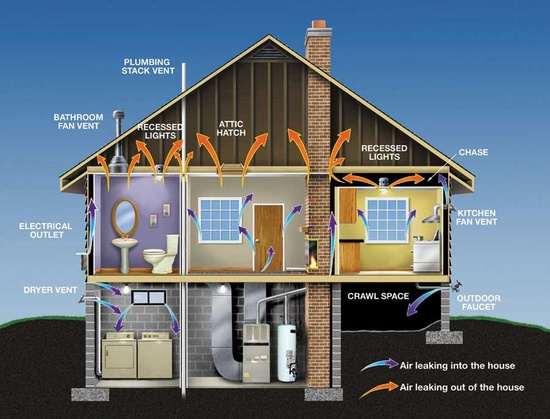
Improve energy efficiency and reduce your carbon footprint by adding home insulation.
For a more detailed inspection, you will need to take the following steps. Attic spaces are a well known source of drafts especially uninsulated or poorly insulated ones. What greatly contributes to this is the fact that contractors often use attic spaces to place wires and plumbing, which usually involves cutting and drilling holes. Well, these holes can be a problem. Simply go up to your attic space and if you already have some home insulation installed, simply check it and if it is anyway damaged that is dirty and black (which can easily be seen if you have rock wool installed), there is most definitely a leakage problem. The same goes for your attic doors and hatches which can have a number of small gaps and holes leading the cold air from the attic to the rest of your home.
Another great source of energy loss is your basement space, especially around the foundation wall rim joists and basement windows. Just like attics, basements also hold wires and plumbing which are usually not sealed, allowing the air to get straight inside your home. Point a flashlight along the foundation walls and if you can see light coming through or feel cold air, you will need to seal those holes and gaps around electrical wires and cables. The same goes for your basement windows, especially if they are single paned with no insulation added. The problem can even be more serious if you have a furnace located near the windows, since draughty windows will let the cold air in, the furnace will suck it in and blow it into your home, resulting in decreased energy efficiency. Finally, check the rim joists which are totally exposed to the outside and probably already insulated. If not, this could be a great chance to do so.
The Second Step – Fixing Air Leaks
Now we are down to fixing air leaks. So let’s start from the most common places that need to be taken care of and that is your windows and doors. If you are dealing with older, squeaky windows or doors, it would probably be best replacing them. However, if this is too pricy for you, you can always opt for weather-stripping which is nor too expensive nor too complicated to install.
Another area worth taking care of is your plumbing and ductwork. All the pipes and other penetrations placed in the exterior walls need to be air sealed. You can do this by removing the collar from the pipes, spraying expansion foam into the wall opening, when it dries cutting it accordingly and caulking any remaining gaps and holes.
Finally, probably the greatest source of energy loss are walls, ceiling and floors, especially, as mentioned before, if there is a basement located underneath or an attic above. All these areas should be properly insulated, but there are a few additional things you can do. Firstly, make sure to cover the insulation with a proper vapour barrier which will protect the insulation material and your walls from penetrating moisture. Another valuable advice could be adding some rigid insulation board on top of the attic door or beneath crawlspace doors, however always taking care of proper ventilation especially in crawl spaces. Also, make sure to insulate your home foundation which can be done with nothing more than some strong plastic sheet placed underneath your house.
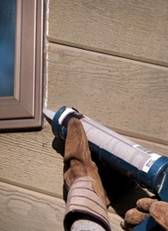
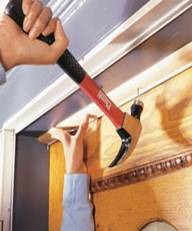
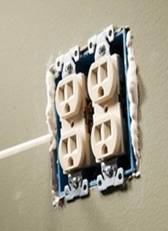
Hopefully, all the above explained convinced you that all these problem need to be solved timely since some researches have shown that unsealed homes lose up to 30% more energy, which only shows that fixing air leaks can drastically add to your home insulation and improve its energy efficiency.
Think you are a jack of all trades when it comes to home insulation in the UK? Share some practical advice on fixing air leakes and inspire other to pick up the tools and join the Green wave!

























































































































